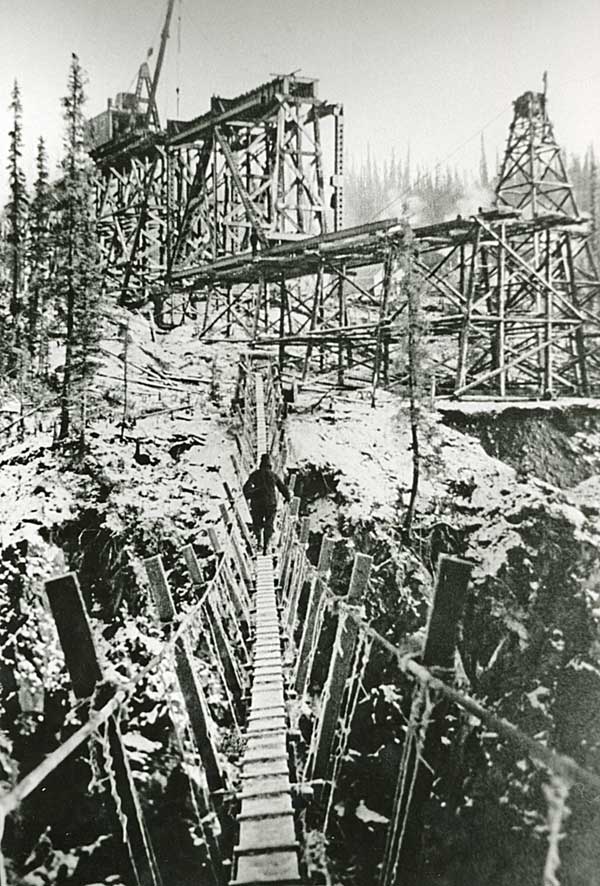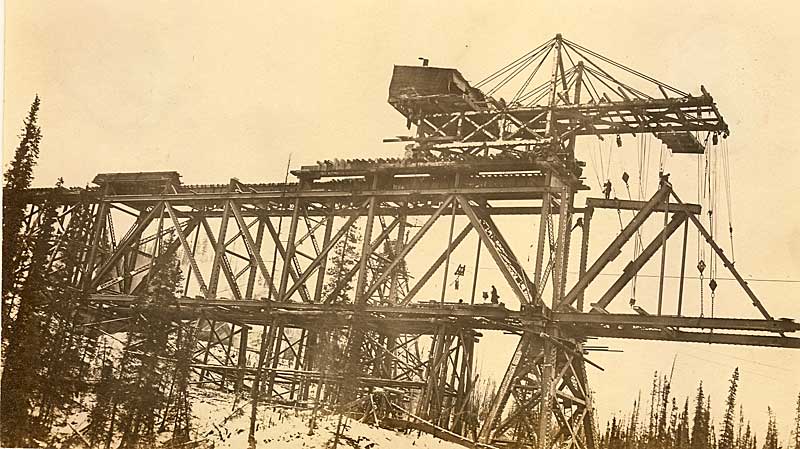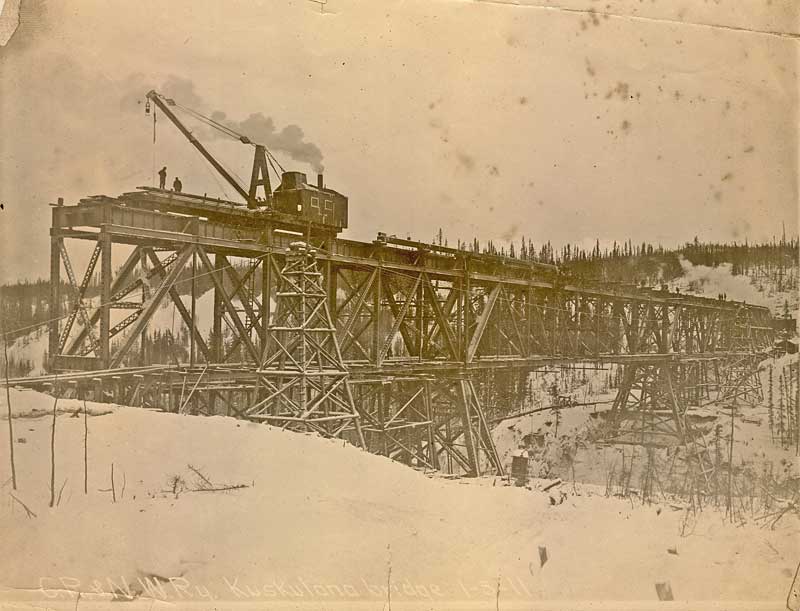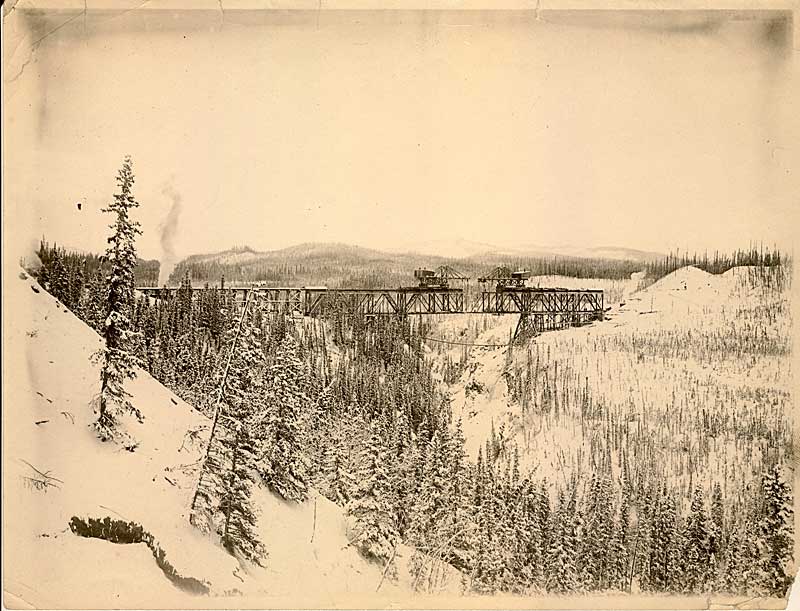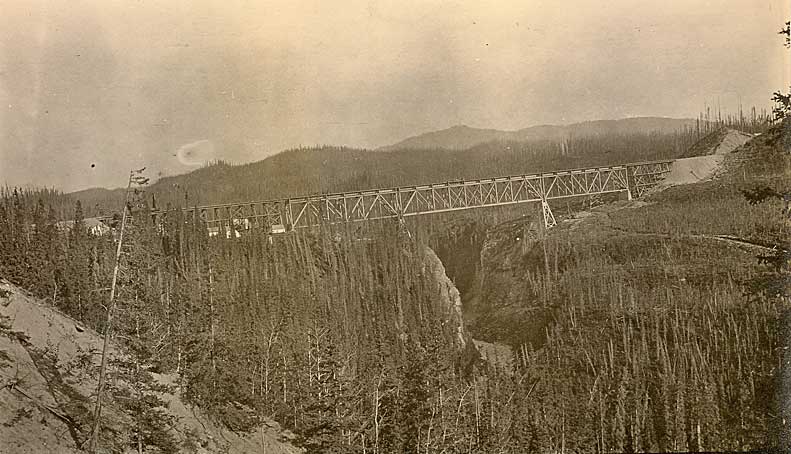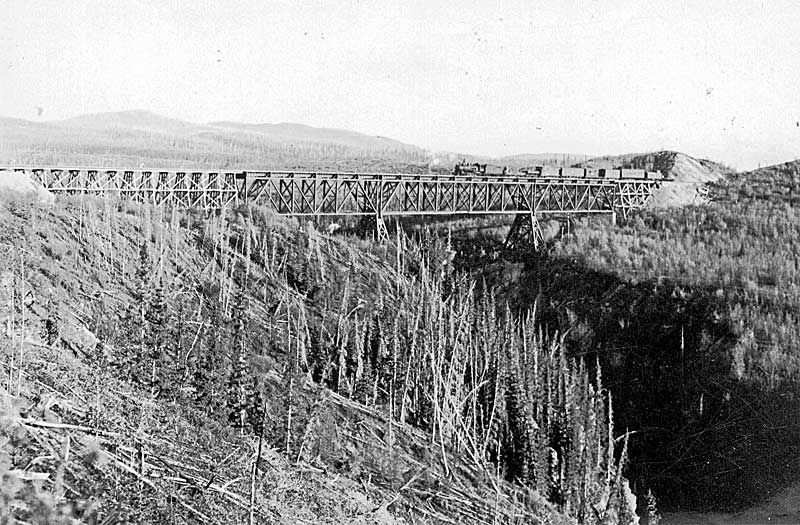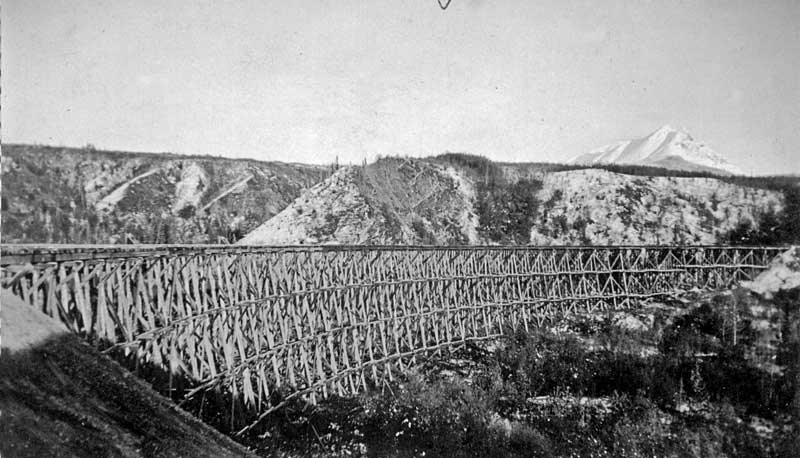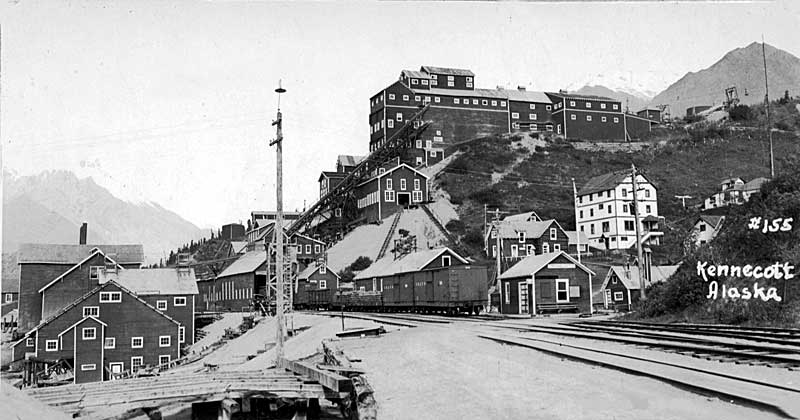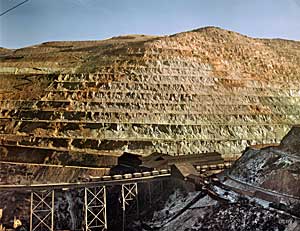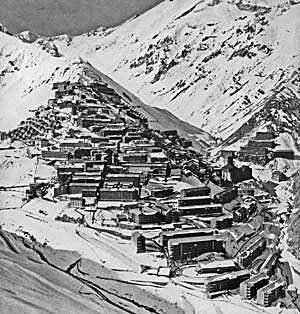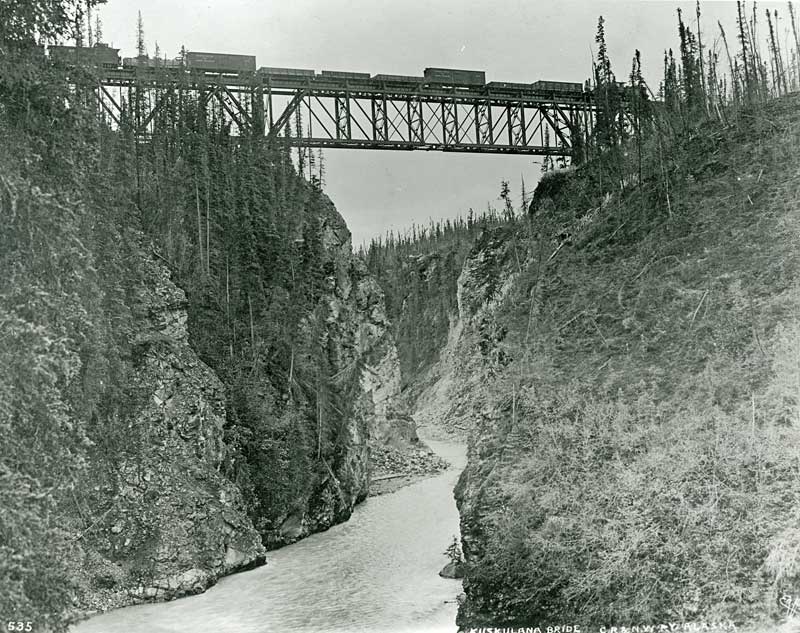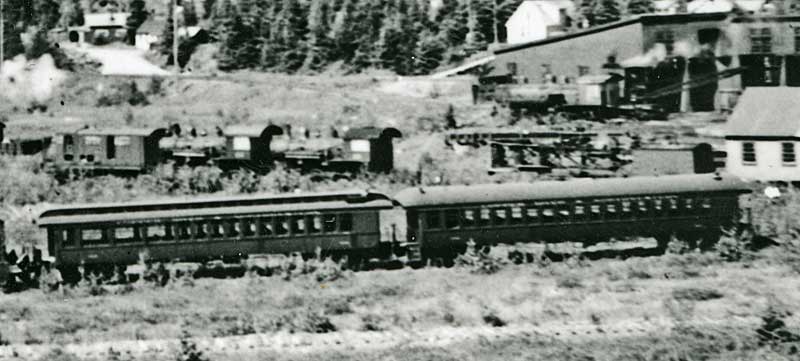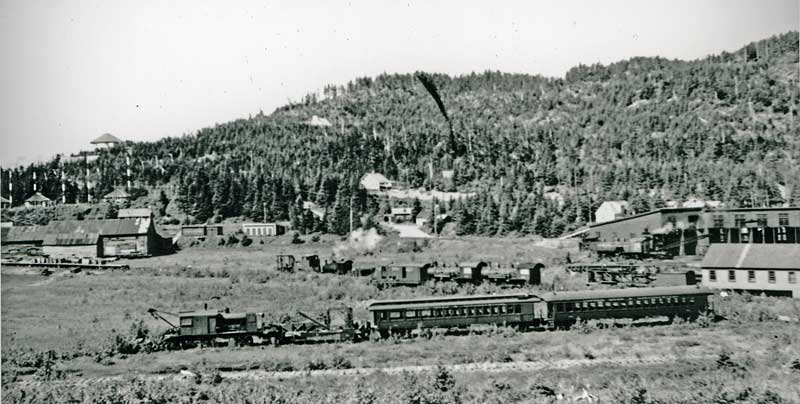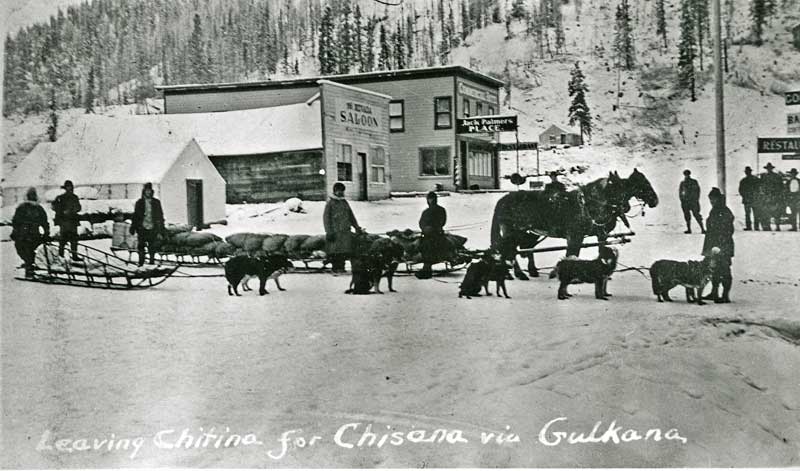Legacy of the Chief, Chapter 18, Pt 2: "Birch Private Train #73-19"
Chapters from the historic novel "Legacy of the Chief," by Ronald Simpson, and other items mostly related to the historic background of the Ahtnas in the context of Kennecott Copper & its Copper River & Northwestern Railway.
13 November 2010
Ch 18, Pt 1: "Birch Private Train #73"
Legacy of the Chief, Chapter 18, Pt 1: "Birch Private Train #73-1924" |
09 November 2010
Ch 17, Pt 2: "Interview at Chitina"
Legacy of the Chief, Chapter 17, Pt 2: "Interview at Chitina" 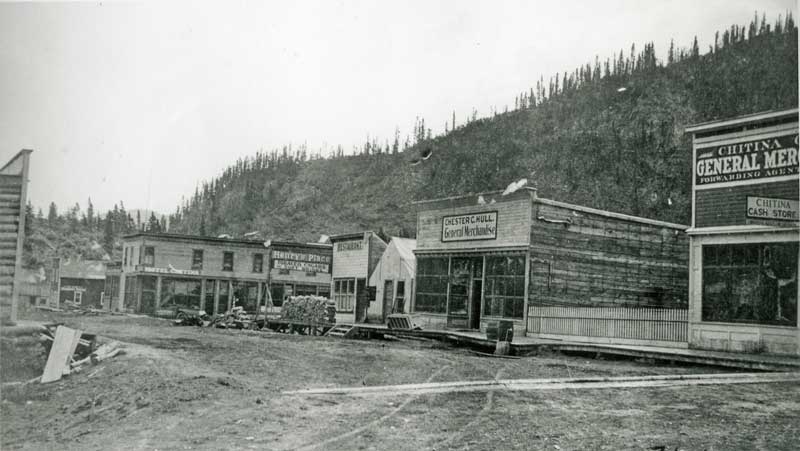 The view from near the Fairbanks Saloon, including the Hotel Chitina to the north. --Cordova Museum I grabbed a cue stick and stepped forward. “Why don’t we enjoy these cigars first? I’m in no hurry to get slaughtered like Frank was.” “Sure, the game can wait. I’ll have your dollar soon enough. No one else is waiting to get in on our action,” the Indian replied. We sat back in the wood and leather chairs and lit up. I must say that when one is in the middle of nowhere--and Chitina certainly qualifies--that even a second-rate cigar tends to taste first-class when there are no other choices. I turned to the Indian. “Can you tell me something about yourself?” “Not much to tell. My father is a first generation Polish immigrant. He met my mother at Copper Center during the rush of 1898. He was one of a few hardy survivors who made it over the Valdez and Klutina Glaciers. I was born in the village of Klaw-tee-kaw, near the Copper Center trading post. Dad stayed in that area to trap. He was looking for gold, thinking like all the other white men that he’d make it big time. He must have panned every little stream in all directions from the Tazlina to the Bremner. He made money off his trapping, but nothing much from his gold-panning. “My grandfather was the renowned Chief Nicolai, the tyone of Taral.” “I’m afraid I’ll have to reveal my ignorance. I never heard of the tyone of Taral.” “I’ll tell you the short version of the real Ahtna Indian story. He was a young man when the U.S. Government sent Henry Allen on an expedition up the Copper River back in 1885. Allen expected to find Nicolai at Taral, but Grandfather was up in the sheep country doing what he loved the most, which was stalking Dall sheep. A prospector at Taral named Bremner told the lieutenant that nothing good could happen without the blessing of the chief.” “Where is Taral?” “Taral no longer exists, except as a spirit camp. It was across the Copper River a few miles downstream from here. No one has lived there since the railroad came.” “Nicolai’s brother Skilly was at Taral. He agreed to lead Allen’s party to C’ena’ tsedi, the chief’s winter home. Henry Allen must have been really surprised to find that the great chief was a small man who was only eighteen. 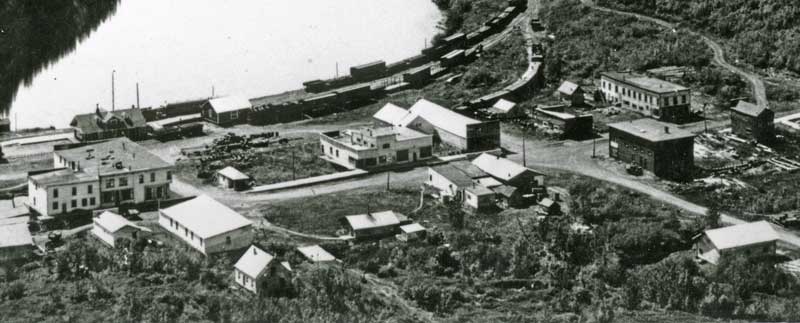 Birds-eye view of downtown Chitina as it would have looked in 1923: The billiards hall and card room is in the center. --AMHA, B82.188.3 “I know it’s hard to imagine now, but an eighteen-year-old really was the tyone, which means supreme chief. All the other chiefs had learned the hard way that Nicolai would stop at nothing to get his way. He wasn’t a violent man, but he feared nothing--man nor beast. “He was just plain powerful and forceful. He always backed his words with action. No one else did that. Not like Nicolai. His words always carried the greatest weight of any all his life.” Johnny took a puff from the Dutch Master and leaned against the back of the wooden bench. “Besides, he controlled Taral at head of Woods Canyon, which is on the way to Alaganik where our people traded with the Eyaks. No one could pass Taral without stopping there and paying homage. Nicolai always made sure of that. He had British guns from Hudson’s Bay Company. He was known to fire upon our own people to warn them not to pass without coming to shore first to pay the price of passing. One chief from Mentasta tried to sneak by. He changed his mind in a hurry when Nicolai fired those gunshots. Around here, everyone respects the Mentasta people as the most warlike and dangerous. But Nicolai feared no one.” I noticed that it was not getting very dark outside, even though the hours were moving along. But the two-story buildings lining the street were mostly dark and shadowy. Only the lobby of the Hotel Chitina was lit. No one was out there. No trains sat at the depot, either. The town was beginning to appear very eerie in the shadows of the evening, taking on a sinister quality. “Because Nicolai was of a slight build, he could never let any man think there was any possibility of taking advantage of him. Several tried. No one succeeded. He was physically powerful, but more than that, he had nearly complete self-discipline and the self-assurance which comes with it. “Our people up river always feared the Russians who they were certain would return some day to take revenge for what the Mentasta and Slana people did to the Russian expeditions. But they rested easier knowing that Nicolai was guarding the river at Taral. Everyone knew he would die before letting a Russian pass.” Frank leaned forward, completely absorbed and fascinated by Johnny’s tale. “ I grew up in Chittyna, the Indian village up the hill. I visited Grandfather Nicolai whenever I could. He was remarkable. He always seemed to know everything going on around him. He treated me and my brothers and sisters with kindness, even though some of us are half-breeds. “He never said it in so many words, but he seemed to expect more out of me than the others, except maybe for my brother Cap. He told me that many of our people were not ready for the great changes, so it was up to those of us who could to educate ourselves in the white man way. He wanted our people to adapt to the new way without losing ourselves in the white man’s world. He told me that I was given a great gift, and that I owed it to the Creator to do the right thing for our people since we now had to share our land with white people who do not understand us.” Johnny looked straight at Frank and me. He paused and re-lit his cigar. “We’ve been forced into a world we never chose. We’re no different from anyone else except that we know where we’re from. We’re tied to our land. The white man is lost. He has not roots and no feel for the land. He would rather rape it than try to live with it. We can live with the white man, but not his foolishness. It’s been a hard-fought battle for us, but we think we’re finally making some of you understand why you can’t change us. You would not want to. We’re all that stands between the white man and a world that would destroy him if he continues as he has.” The sound of a fiddle playing started coming through the wall from the adjacent saloon. Along with it was the distant hum of people talking. “You hear that? It’s a white man’s bar. They’re all white man bars. None of us go in them. They won’t let us. Maybe it’s just as well.” He paused long enough to listen to the tune through the walls. “Our potlatch music sounds better. Where was I? Oh, yes. “Grandfather said to me that I could not believe the leaders. Their words, especially the ones written on paper, were usually no good. The tough part was separating the good men from the bad. Some men are sincere and want to understand us. Others are here only to take advantage of us and destroy the land. Our people are humble and trusting. They can be easily fooled.” 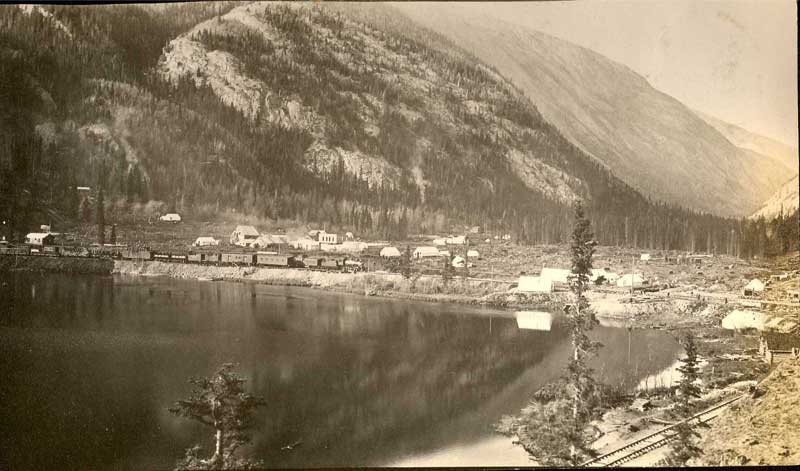 Summer & Winter views of early Chitina in 1910 --Van Cleve collection 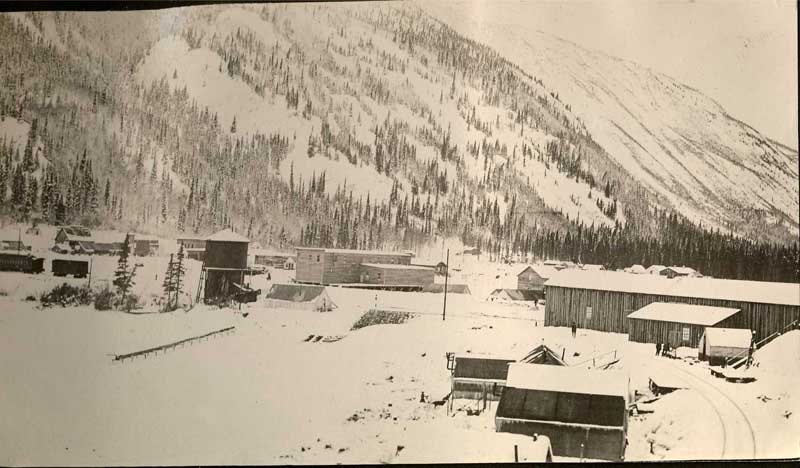 He paused to look out the window. The buildings across the street had become dark, forbidding outlines of something which appeared to stare back at us with malice. The small town had taken on a distinctly evil character with nightfall. “Grandfather said it would do no good to hate the white man. “Look at your father, he would say. Not all white men are bad. They were born into their world as we were born in ours--a choice none of us made. ” “He had a sense of how the world works that would put most white men to shame. He knew how to make his knowledge and understanding count by his own actions. He used to tell me if you say a word, you must follow it. “We have been lied to by so many white men that it is easy to think we are justified to defy him at every turn. That’s not what grandfather taught us. He said that our word is everything, and our actions must follow our words. Don’t let the lies of others become an excuse for you to lie. And then he would say to me get your education, Sa’gaw’nee. We are all watching you and waiting. “So here I am. I had to fight a lot as a kid. Sometimes I still have to fight. The white men on the railroad can show incredible stupidity dealing with us Indians.” “You work for the railroad?” I asked. “I sure do. I always liked the railroad. It has not always done right by us, but I like the iron machines. We call them the ket’chee ten’eh. They are far more than just metal. Each one has its own spirit. I know every one of them by the distinctive sounds of their whistles.” The card room door opened. Two of the older men entered the room. “I have to go, Sa’gaw’nee. The old woman wants my help on the fish wheel tomorrow.” “I have to find my son, Michael. I need his help. Have you seen him?” “No, Sez’ae, I was expecting to see him tonight.” The two walked stepped outside and turned right, heading toward the Indian village west of Chitina, I assumed. “The man looking for his son is Chief Goodlataw, my mother’s brother. I grew up in his household. We call his son Cap.” “The one you called your brother?” “Cousin and brother mean the same to us. Cap and I work together on the railroad. That other man is Doc Billum. You may have heard of him. He was a friend of Nicolai’s.” 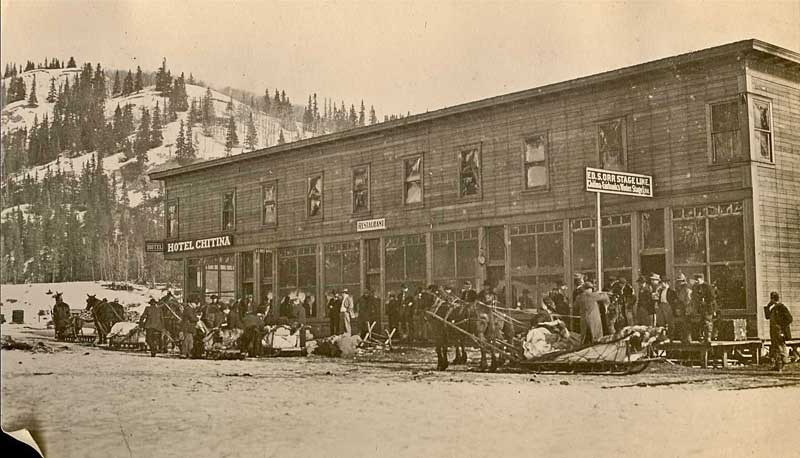 Hotel Chitina in 1911 --Van Cleve collection Billum was a much older man with a poker-face. He was the one wearing the tall top-hat. Doc Billum was completely expressionless, except that his eyes revealed a rare depth of feeling. The younger man might have been in this forties. He was intensely good-looking and a broad smile. Both men had a strong charismatic aspect to themselves. “Grandfather died because of the Spanish flu of 1918. Many of us have fallen to the white man diseases, mostly tuberculosis, measles and smallpox. Those of us who survived are stronger for it, but not necessarily happier. Grandfather said that it must happen like this. He told me that pestilence hits all peoples. It is one of the great trials of life. Suffering and adversity allow the Creator to see who is worthy before Him.” Johnny paused for a long time. No one said anything until I finally spoke. “You have obviously given much thought to your situation. What do you plan to do next, Johnny?” “I want to work at Kennecott, where my father Emil works. Frank has told me that he will try to get me on there. Kennecott is not like the railroad. It is not known to Natives, but Frank says that he has the ear of the superintendent. I hope you do, Frank. I want to go there. “I have spoken long enough. Talk to Frank now, so I can enjoy this cigar.” Johnny got up from the bench and walked into the card room in back. “What a fascinating young man. How about yourself, Frank?” “I’m a mining engineer. Kennecott has been going through some very interesting times lately. Superintendent Bill Douglass contacted me at Butte Montana, where I was working for Anaconda Copper. He asked me to join his team here in Alaska. He worked at Butte some years back and somehow found out about me from one of the engineers he knew from those days. “I don’t know him personally, but he was well known around the Anaconda Copper Mine at Butte. My superior, head engineer Bob MacIntire, told me that this was the kind of opportunity that a young geologist like myself should not miss. He said that Bill Douglass is first class, not just as an engineer, but as a person. Bill was well liked and respected at Butte. Douglass offered MacIntire the job, but he turned it down and recommended me instead. Bill Douglass took MacIntire’s word, which was a surprise to me, and offered me a position on the Kennecott engineering staff. “Kennecott is pulling out more ore than ever. You’ll probably see a full ore train through here tomorrow heading toward Cordova. Douglass wrote me that they’re running full trainloads six days a week, which is full capacity.” “So are you married, or do you have a family somewhere?” I asked. “My parents are both gone now. I’m the only son, and I have no sisters. I’m not married and I have no close relatives. Going on a remote assignment like this is appealing to me since I have no ties, anyway.” “What about your engineering background?” “As I said, I’m a geologist. I was searching for new ore prospects at Butte. We were always looking for new ore formations. I came straight from the Colorado School of Mines. While I’m hardly the greatest engineer, I did fine in mining school. I really enjoy being out in the field. I grew up around gold mines. They fascinate me. I’m also a war veteran. I’m one of the lucky ones to have lived through it. I learned a lot about leading men as a young lieutenant over there.” “How long do you intend to stay?” “I love this country. So far, it’s what I expected and much more. This is the most exciting place I’ve ever been. It’s like Wyoming, but more intense. More raw, more, well, more everything. What can I say? You just came from a trip which brought you right through the Alaska Range. You saw part of it for yourself. “Would I ever want to go anywhere else? I don’t know. But I know that right now, this is the place that suits me. “Even being here in this little obscure place called Chitina has been exciting for me. I must tell you that this Native fellow Johnny Gakona is remarkable. If I can help him up there at Kennecott, I certainly will. He’s right, you know. He didn’t actually say it in so many words, but we took this land from him and his people. We’ve tried to take their language and their old ways from them by punishing their children in our schools. Maybe we should be prepared to show more respect to these Natives. I hate to imagine what some of them must really be thinking each time a fresh new white guy like me comes into this territory doing things to the land which they never imagined would happen. “Dad taught me to respect them. After all, they had survived the land long before any of us ever arrived. We really did those Indians in the States considerable harm. The common thing among us whites is to ignore these people like they don’t even exist. How arrogant can we be? I don’t want any part of that attitude.” Johnny walked back in through the card room door. “I’ll bet you guys never thought an Indian could get this stuff!” He had a full bottle of whiskey. Johnny reached behind the counter and pulled out three glasses. “I know what you’re thinking. We’re not going to pass the bottle around Indian-style. After all, this is downtown Chittyna. It’s a classy place here. Can’t you tell? And I’m not your average cigar store Indian.” With that tongue-in-cheek remark, Johnny handed each of us a glass and poured. Lifting his glass, he said: “Cheers to you visitors. May you find what you seek here. Who has the table? Time to get serious and put up your dollar!”
|
Ch 17, Pt 1: "Interview at Chitina"
Legacy of the Chief,
Chapter 17, Pt 1: "Interview at Chitina"
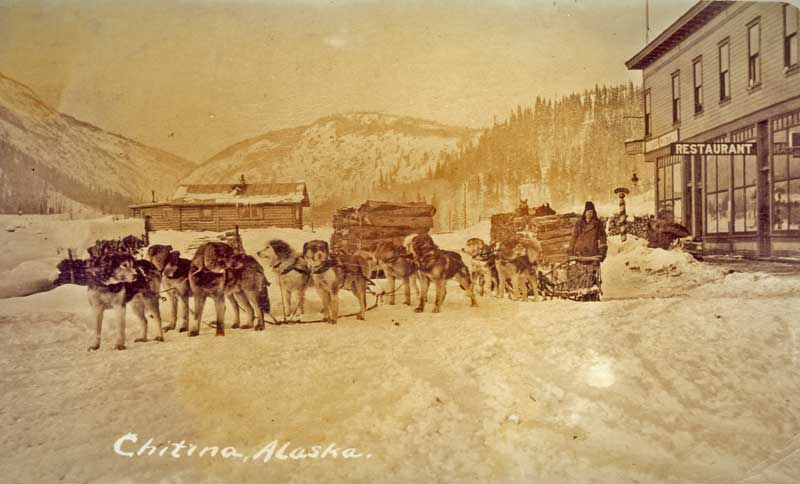
Early view of the Hotel Chitina, Ed S. Orr Stage Lines
office in background, now the Chitina NPS visitor center cabin.
--courtesy of the late Bruce Haldeman
It had been a very arduous journey from Fairbanks,
working through an endless series of mosquito-infested mud bogs down the
Richardson and Edgerton Trails to reach dusty Chitina, a railroad town
located 131 miles from Cordova. John DeHaviland, the free-lance writer
finally took his long-awaited bath in the relative luxury of the
Breedman’s Hotel Chitina, followed by what he considered a truly first
class meal in Breedman’s Restaurant. The hotel was empty of guests. It
had dozens of rooms, but few were occupied. The lobby was empty, lacking
even an on-duty clerk. That function was being handled by the waiter in
the restaurant. John decided to see if any night life existed in the
small town of less than 200 people.
working through an endless series of mosquito-infested mud bogs down the
Richardson and Edgerton Trails to reach dusty Chitina, a railroad town
located 131 miles from Cordova. John DeHaviland, the free-lance writer
finally took his long-awaited bath in the relative luxury of the
Breedman’s Hotel Chitina, followed by what he considered a truly first
class meal in Breedman’s Restaurant. The hotel was empty of guests. It
had dozens of rooms, but few were occupied. The lobby was empty, lacking
even an on-duty clerk. That function was being handled by the waiter in
the restaurant. John decided to see if any night life existed in the
small town of less than 200 people.
All was quiet in the hotel, so this roving writer headed for the one
place that appeared to have some action on this midsummer night. Across
the main business street, which is dusty avenue that has been torn up by
a procession of heavy wagon and car wheels, is a block containing a
saloon and a billiards hall and card room. The street appears to end
just three blocks beyond that at the Commercial Hotel. Nothing else
appeared to be happening elsewhere along the avenue.

The ghost town of Chitina, 1953: The Fairbanks (later
Trimm's) Saloon and the card room are on the right. --AMHA,
McCutcheon Collection, 6-2481-53
The narrow billiards hall has two large plate-glass windows facing south
toward the Chitina Cash Store. The store was dark, but a peek through
the windows revealed an extensive, well-stocked general store of the
type once common everywhere in the old west prior to the turn of the
century. Just behind the store is the railroad depot. The depot faces
Town Lake and Spirit Rock, a rounded basalt dome several hundred feet in
height, which shoots nearly straight up on the other side of Town Lake,
dominating the small town’s south view.
A single billiard table dominated the narrow front area. Along the back
wall is some kind of service bar--though there was no liquor in sight,
and I don’t believe that this place was a licensed liquor establishment.
Just beyond is a door leading into a small a private card room. The
grizzly looking old man who calls himself Smitty told me that the poker
game in the rear was full. A quick look inside the smoky room confirmed
it. The card room was full of older Indian men seriously involved in a
game of poker. One of them wore a tall top hat. All of them looked at me
for a brief moment, then returned to their business at the table.
In front were men in their mid-twenties shooting for money at the
billiards tables. The young Native shot like a professional. He looked
up from a series of moves he appeared to be contemplating, walked over
to me and introduced himself.
“My name is Johnny Gakona. Haven’t seen you here before, but many people
pass through this town, then continue on. Welcome to Chittyna.”
He pronounced it Chit-tee-nah. That must be the original Indian word. I
have heard it only as Chit-nuh from the white men.
“I’m John DeHaviland. I just came down the Edgerton on Orr Stage Lines.
Where’s all the action, tonight?”
“This is a quiet town. You won’t see much here. But, you came to the
right place. Put up your money, and you can play the winner.”
“Pardon me, but you look like a pro. It looks to me like your planning
several shots in advance.”
“I always do that. Learned it from my grandfather. He taught me to plan
my moves ahead. It works. Seldom lose that way. This is my opponent. I
just met him before you showed up. As I said, you might as well join
us.”
The other man stepped foreword.
“Buckner, I’m Frank Buckner, originally from Wyoming. Glad to meet you
John.
Please join us. Not much else to do tonight unless you’re a poker
player--or a drinker.”
“I’ll be pleased and honored to join you, even though I suspect I don’t
stand much of a chance against this Indian pro. Any cigars here?”
“You’re in luck,” the grizzly old man answered. “The train brought in a
fresh selection.”
“How about one for myself and one for each of these gentlemen? Three of
your finest,” I said, probably too expansively. “By the way, I’m John
DeHaviland.”
“They call me Smitty,” he said as he held out a box for my perusal. I
saw nothing really fancy there, but I took three of the Dutch Masters.
“That’ll be sixty cents for the three of ‘em.”
It seemed high-priced for what I was getting, but I took them without
saying more, and turned back towards the billiards players. Smitty
disappeared into the card room, leaving me alone with the other two men.
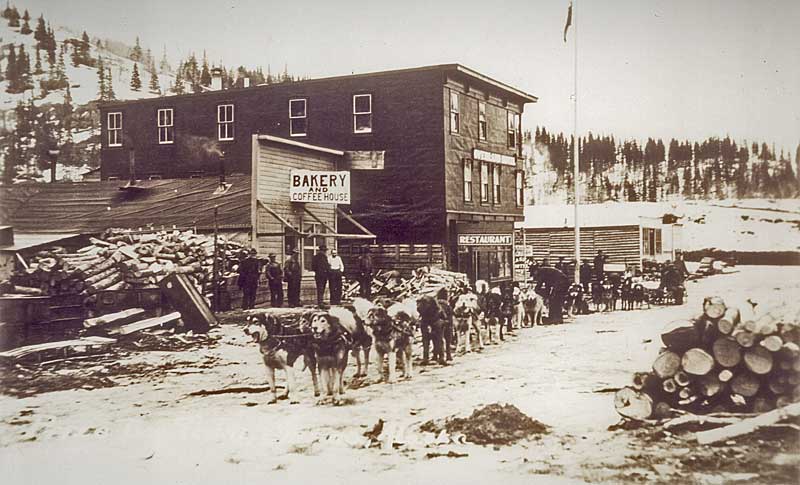
Bakery, Overland Hotel, Fairbanks Saloon and the card room /
billiards hall, circa 1913 --courtesy of the late Bruce Haldeman
“What brings you to our remote part of the world?” the Indian asked.
“I’m a free-lance writer. I travel a lot and do special stories of wide
interest for the San Francisco Examiner and other papers. My specialty
is what I call the rise and demise of the American west--you know, gold
rushes, opening new territory, following the politicians, the judges and
others who help shape it into what it is. I came up to Alaska pursuing a
story on President Harding’s visit.”
“Our land is not shaped by politicians and judges. My people have been
here for thousands of years before the white man ever even knew we
existed. White settlers and prospectors and railroad men live among us
now. They’ve been here for the last twenty-five years. We’ve accepted
that, because they’re far more numerous than us. But we want nothing to
do with their politicians, or their judges, or their lawyers.”
Johnny Gakona took a shot. He missed. It looked like a deliberate miss
to me. The other man stepped forward to shoot. Johnny continued.
“The politicians and others of their kind have never brought anything
good to us. They don’t live here. Let them try to live here. We still
live much as we did before the railroad. Those people don’t know us, or
understand us, or care if we even exist.”
He held up the unlit cigar I handed him.
“By the way, thanks for the cigar,” he said as he made another shot.
“None of us, even the whites, want to hear about politicians or judges
or any of those others who think they can do what they want with our
land.”
An articulate Indian. Not many of them to be found. I just found a good story. |
“I hope you don’t mind me writing this down. This might be a good
story.”
“Write what you want. I can’t stop you.”
“You don’t have to talk, though. Many Indians won’t talk to us reporters
or writers.”
“I like it when the white man listens. Just can’t help myself.”
He made a calculated shot and dropped a ball, and then another. Then he
missed. Frank stepped forward with his cue stick, then looked up at me.
“This is all new to me. I just traveled up from Butte, Montana. I’m
fresh to this territory. I think there’s a word for that.”
“Cheechako. That’s what we call you newcomers.”
“That’s it. When does one become something else?”
“You mean a sourdough? In your case, never.”
Johnny chuckled and took another shot. He landed it.
“What about you Indians?”
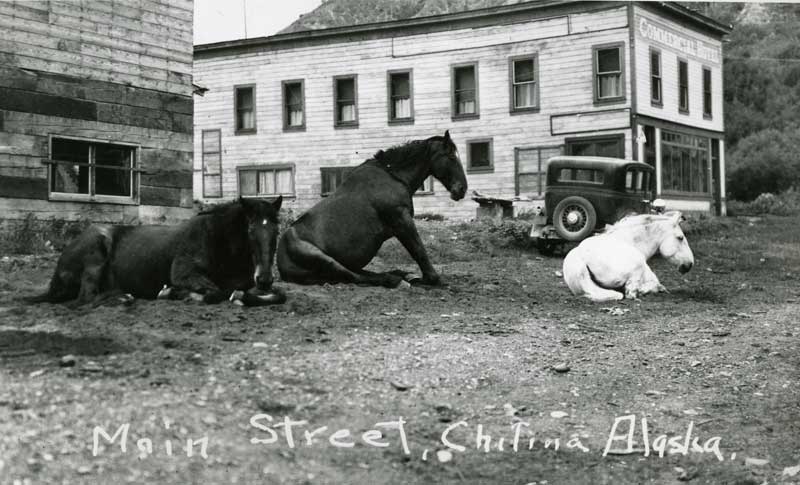
Main Street, Chitina, showing the Commercial Hotel
--AMHA B71.X.5.37
“Call us what you like, but don’t call us cheechako, or sourdough, or
white.”
He paused for a moment.
“I would stay away from siwash as well. That word might prove painful to
you.”
He looked straight at me, then turned his attention to the table. He
missed the shot. Frank stepped up to the table.
“When I was a kid growing up in Wyoming, Dad taught me to respect the
people who were here before us. I met a few of them. None spoke as
clearly and readily as Johnny.”
The ball stopped short of the pocket. That gave Johnny the opening he
needed. He landed the eight ball and extended his hand to Frank. They
shook hands and Frank handed the Indian a dollar coin. Johnny signaled
to me.
“You’re up.”
Ch 16, Pt 2: "DeHaviland Arrives at Chitina"
Legacy of the Chief, Chapter 16, Pt 2: "DeHaviland Arrives at Chitina-1923" 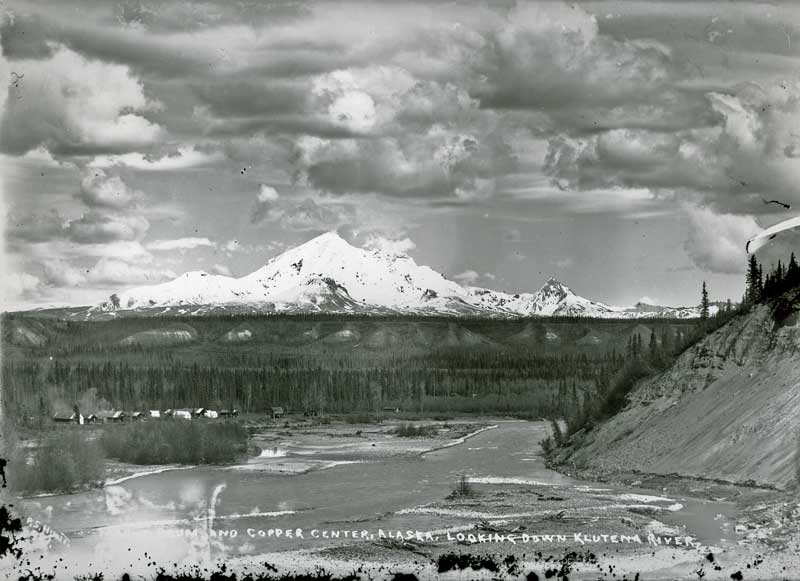 Looking down the Klutina River toward the settlement of Copper Center, Mt Drum in distance. --Anchorage Museum of History & Art, B62.1A.123 The name Copper Center is a misnomer. No copper mining activity ever occurred there at all. The place appeared to be something lost in time. Even the Indian village seemed to be asleep. Like all the others, it showed signs of extreme poverty and obvious government neglect, even in comparison to the rudimentary homes of the few white settlers. If there is any official policy to assist the Indians who live anywhere along the Richardson route, it is the policy of neglect. It is most striking at dusty, forgotten Copper Center. I was told that the name is a result of the area being the center of activity on the Copper River back during the gold rush in 1898 when large numbers of would-be miners made their way up the Valdez Glacier for a very tough climb to an incredibly steep summit, only to follow another glacier down to a lake on the southern edge of the Copper River valley. Several tent settlements sprouted up around Klutina Lake, but the ultimate destination was the Copper River. Those early travelers had to survive the rushing waters of the Klutina River. It was no journey for amateurs. Less than ten percent of those who attempted the trek from Valdez made it to the mouth of the Klutina. Copper Center became a temporary boom town anyway. Regrettably, no gold was to be found anywhere near the area. Copper Center became what it still is. Rather than a destination, it is just another stop along the way. The place remains to this day a destitute, predominantly Indian settlement with no apparent purpose. 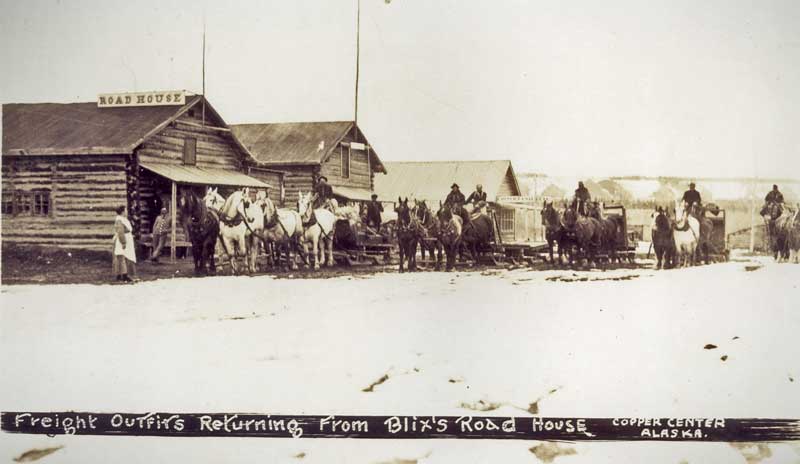 Blix's Roadhouse at Copper Center --Candy Waugaman Collection Even the name Copper River proved misleading. No copper was ever mined anywhere along the river. It is the Chitina River which leads into the true copper country. I am told that chiti means copper and na means river. The southern part of the Nizina and Chitina River valleys became the ultimate destination for many of those stragglers who survived the Valdez and Klutina Glaciers. It was the area of another fizzled Alaska gold rush. It would not be the gold which would place the Copper River valley on the map, but the copper. The enormous Bonanza vein outcropping brought in the railroad. For a while it looked as though the railroad would be continued through Copper Center when a right-of-way was surveyed following the Richardson route. Property was even set aside for a railroad yard at Copper Center. J.P. Morgan, who owned the CRNW Railway at that time, dangled the railroad in front of the federal government, touting it as the easiest and cheapest way to have a government-owned railroad accessing the gold fields around Fairbanks and elsewhere in the interior. He even offered the line from Cordova to Chitina to the Federal Government for less than cost. The Wilson Administration had other plans. They bought up the old Alaska Central Railroad right-of-way out of Seward and developed the town of Anchorage from the terminal they built at Ship Creek in 1915. As a result, the CRNW Railway never extended beyond Chitina to Copper Center and never will. It will always be just a mining railroad, albeit a very large one. Copper Center became another historical curiosity which will probably never amount to much. Even the agricultural experimental station and the fox farm have long since gone by the wayside. Civilization never really arrived at Copper Center. The route from Fairbanks to Copper Center is littered with high hopes and lost dreams. Many of the lodges are dead or dying. The remaining ones appear to be over-built. The trail is interesting, but rigorous. It is not a practical one to follow now that a full-service railway exists between Seward and Fairbanks. The only activity of any consequence exists along the railway line which passes through Chitina, which is isolated by over three hundred miles of almost nothing. It is truly in the midst of a wilderness.  Junction from Richardson Highway to Chitina by means of the Edgerton Cut-Off. The final leg of the trip closely followed the Copper River. Willow Creek Roadhouse turned out to be nothing but a few cabins. Mrs. Griffith’s roadhouse at Kenny Lake was being expanded, reflecting an unfounded optimism based on a level of trade which will never materialize. In the view of this reporter, few lodging businesses have any chance of surviving in a wilderness which only the Indians can truly appreciate. The lodges along the route were built at a time when gold rush activity justified them. Those days are long over. The final lodge before reaching Chitina was the Lower Tonsina, a two-story modern facility that proved to be a truly wonderful lunch stop. 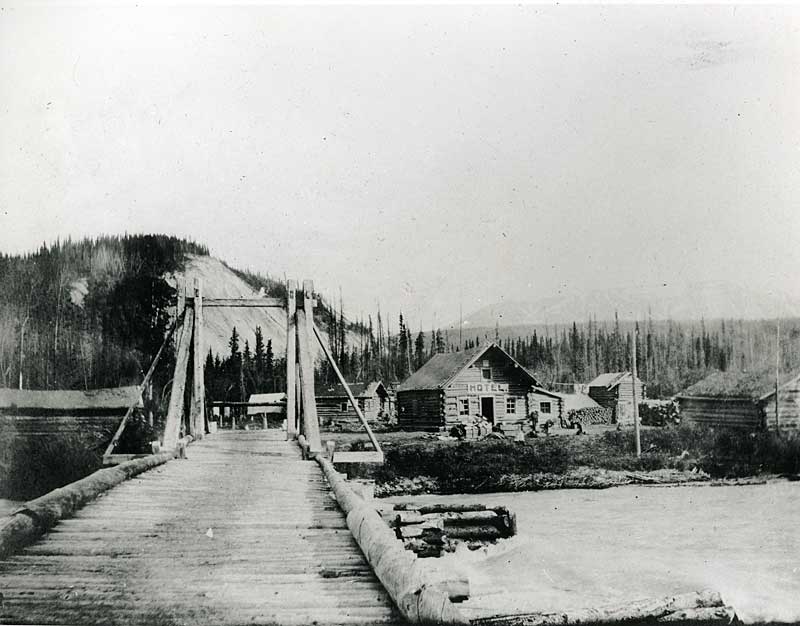 Nafstead's Lower Tonsina Roadhouse on the Edgerton Cut-Off road to Chitina Predictably, the final leg of the trip along the Edgerton Road was much like the tedious run from Fairbanks to Copper Center. Muddy streams and stunted forest lands only served to relieve miles of tundra heavy with mosquitoes. These features are typical of great expanses of the lower country. They are uninspiring and provide nothing of interest to the sophisticated traveler. traveler all the way from Fairbanks. The Hotel Chitina, though out of place in this dusty wilderness, is truly a pleasant surprise and an especially welcome respite after so many days of traveling through such primitive country. The entire downtown area is steam-heated and has electricity and running water. One just wants to stop and rest in a large, warm bathtub and find badly needed relief from many days of bone-jerking, mud-crawling, irritating, mosquito-infested travel. This is just the place to do it. This grand establishment is Oscar Breedman’s Hotel Chitina. It is the largest hotel in the interior. Sadly, even this hotel is largely empty. Only about a dozen of its seventy rooms are occupied. Once the Alaska Railroad reached Fairbanks, the Cordova to Chitina to Fairbanks run became nothing more than an annoyance. Down the muddy street, heading west, the Commercial Hotel, which caters mainly to the miners and other travelers of limited means, is less than half full. The lot where the three-story Overland Hotel once stood remains a charred empty spot, unlikely to ever be re-built. All that remains are the tourist runs. The one out of Valdez follows the Richardson Trail to Tonsina Lodge--a well-established overnight destination. The following day the visitors travel to the cut-off for forty-mile trip to Chitina. The third day involves the highly scenic ride aboard the Copper River and Northwestern, featuring first class dining service to Miles and Childs Glacier before the train terminates at to Cordova , leaving the passengers at the upscale Windsor Hotel before departure on an Alaska Steamship liner. Tourism is strictly a summer business. One can only imagine how quiet it must be in this very remote sub-arctic Alaskan outpost in the winter when no such traffic exists.  Tourist buses making a brief stop at Summit Lake along the Richardson Trail It is plain as the nose on this reporter’s face that this place is doomed. The vast interior is not dying, it is dead. The people who live here seem to overlook the obvious. The copper will not last. If one was to watch the daily procession of ore trains running through Chitina, it would be easy to believe that it could go on forever. This reporter’s long experience with boom towns of the American West dictates otherwise. The end will come sooner than the residents here could ever imagine. The train will leave one day, never to return. There will be no rich copper mine, no freight or passenger service, and no tourists. It will simply end. Most likely, the mine and railroad will die a sudden death, and few will see it coming or believe what they see when it happens. But it will vanish. Mark my words and place a flask of the finest brandy and a box of good Cuban cigars on it. This reporter picks sooner rather than later. The white settlers who depend on the railroad should count themselves lucky indeed if they get fifteen more years out of it. The railroad will quit running and the country will return to the Indians. Undoubtedly the Indians applaud the end of the copper and the railroad. Not all that long ago all this was their land. It appears to this reporter that it will soon be exclusively theirs again. This writer does not mince words. That’s why he is an independent reporter. Let’s call it like it is. The Indians probably won’t even miss us. We have done them no favors here. Time to think about heading home before the welcome mat wears completely out. 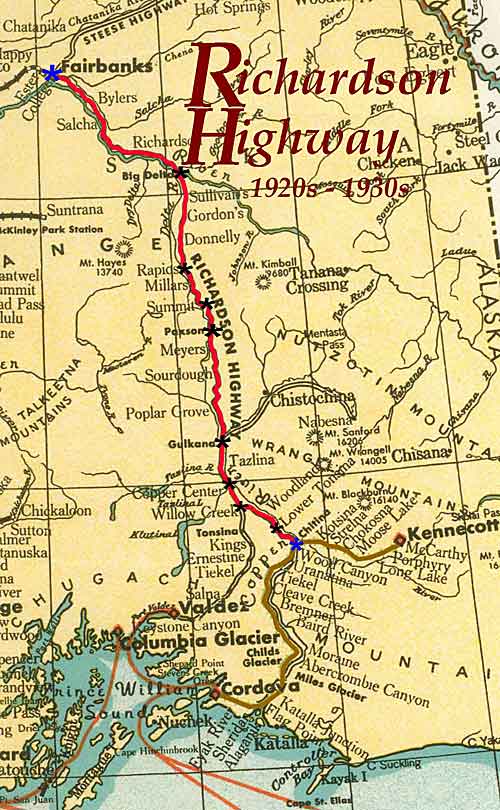 Map showing the locations mentioned in John DeHaviland's itinerary along the Richardson & Edgerton Highways, Fairbanks to Chitina, 1923. This dispatch goes to the San Francisco Examiner by way of the government mail pick-up at the Wells-Fargo telegraph office, the CRNW railroad depot, Chitina, Territory of Alaska. --John DeHaviland, July 25, 1923 |
Ch 16, Pt 1: "DeHaviland Arrives at Chitina"
Legacy of the Chief, Chapter 16, Pt 1: "DeHaviland Arrives at Chitina-1923" |
click on picture for larger image: some of these images appear in the book for this chapter. |
buildings and combination log and frame structures, looks very much like it came straight out of a page from the Old West. The small Indian village of Chittyna on the hill to the southwest adds one more element of charm to the rustic western atmosphere. But it is the busy presence of the Copper River and Northwestern Railway which dominates the small town. Until recently Chitina was an important trans-shipment site, with passengers and goods moving from Cordova on the coast, having arrived in the Territory by means of Alaska Steamship, thence to Chitina by train, and finally by way of Orr Stage Lines through Copper Center and on to Fairbanks. Main Street, Chitina, ~1913 --Cordova Museum President Harding and wife came to Alaska to dedicate the new government railway with the driving of a golden spike at Nenana. Their original plans included taking the Richardson route from Fairbanks to Chitina. Then the Presidential party was to board a special train for the scenic ride to Cordova. After a full day of sightseeing the party would then depart Cordova by way of Alaska Steamship and return to the States. Since Harding canceled this interior Alaska part of the trip in favor of a quick return to Anchorage by rail, then on to Seward and finally Cordova for only a very brief visit, this adventurous traveler decided to take the route, as it was originally planned, to experience what the Presidential party missed. President Harding on AKRR observation car during his 1923 visit to the Territory of Alaska For those of you desiring to take this sojourn from Fairbanks to Chitina or Valdez, be aware that the Richardson Roadway is in most places little more than a rough trail. Much of the roadway is subject to delays due to washouts, slides and other problems with river crossings, such as missing bridges. Mud and tundra are in abundance, as are hoards of mosquitoes. Although the old horse teams have recently given way to modern motor buses, all too often the passengers have to assist in pushing the bus out of the mud bogs which quickly become an all too familiar aspect of the trail. Those inconveniences aside, the trip is nothing if not spectacular as long as one keeps his eyes looking upwards toward the mountains, starting from the very beginning of the journey where one leaves Fairbanks and immediately encounters the panoramic view of the northern slopes of the Alaska Range. One of the most recognizable peaks is Mt. Hayes, which can be seen clearly all the way from Fairbanks to Donnelly, close to the half-way point. McCarty Landing ferry on the Tanana River, part of the RIchardson Road, Big Delta, Rika's Roadhouse in background. --Laurie Nyman Collection The traveler will find primitive, mainly one-story log road houses all the way to Richardson, 204 miles from the Edgerton cutoff to Chitina. This hamlet rests uncomfortably along the east bank of the Tanana, justifying its existence as a riverboat landing and a distribution point for the mining settlements of the area. A large two-story log roadhouse, two smaller roadhouses, a general store and gas station are all there to leave the impression that Richardson really is a town. This writer was not impressed. Due to very boggy conditions south of Shaw Creek we arrived late in the afternoon at the Tanana crossing of McCarty. This name is not to be confused with McCarthy. The cable ferry crossing leads to the U.S. Army telegraph station near the Big Delta Roadhouse. The roadhouse was until recently operated by the well-known John Hajdukovich. He transferred the property to Rika Wallen. We took overnight accommodations at Rika’s lodge which looks upon a rocky bluff of the Tanana River, but fails to have a scenic view of the mountains. From Rika’s, the Alaska Range appears to be very close. We’ve already traveled about 100 miles, but still have another 200 miles to go before reaching Copper Center.The most distinctive feature in the area is the large rounded Donnelly Dome. Just beyond the dome looms the Alaska Range at its most majestic, with a series of eternally snow-covered peaks. The boggy trail at the base of the range leaves a high plateau just beyond the dome and begins to follow the Delta River upwards into the mountains. Black Rapids Roadhouse and trading post at mile 227 is yet another rambling one-story structure, but it boasts a great view of Black Rapids Glacier. This stop was once a horse exchange point, but those days are, thankfully, behind us now. Although there were some spruce trees in the immediate area, the lodge appears to be near the top of the tree line. The surrounding rugged valley walls are completely bare and rust-colored. We heard of numerous placer mining operations in the vicinity.  Black Rapids Roadhouse on the Richardson Trail From this point on through the mountains, the stream crossings present the greatest obstacle, and bridges are non-existent. Fording can be hazardous, but by mid-summer most the streams run very low water. Many rock slides cover the trail. At mile 203 we had reached the summit of the Alaska Range. Yost’s Roadhouse, also known as McCallum’s, once operated at the high altitude of nearly 2900 feet Still remaining are a few leaning log structures through which the cold winds appeared to blow almost without relief. This is a very desolate, treeless, but surprisingly beautiful area. Old glacial moraine can be seen everywhere. At this high point, appropriately called Summit Lake, we were at the headwaters of the Gulkana River, placing us in the far northern end of the Copper River valley. Paxson’s Roadhouse at mile 185 was a most welcome sight. It sits in a location sheltered from the wind and consists of a two-story Hudson Bay style log building with a 120-foot-long horse barn. The lodge marks the junction to mining camps at Valdez Creek in the west and Slate Creek toward the east.  Paxson Roadhouse on the Richardson Trail When we arrived at Sourdough Roadhouse at mile 147 we knew we were getting close to our night-time destination of Gulkana Roadhouse. Sourdough is a main Orr Stage Line point with numerous outbuildings, but no view. Another ten miles down the road is Poplar Grove Roadhouse. It consists of a small two-story structure with a single-story structure nearby. This area was particularly boggy and mosquito-infested. At mile 127 is the sizable Gulkana Trading Post and Hotel. It is at the junction of the Eagle and Susitna Trails. The log building overlooks the Gulkana River near its confluence with the Copper. It is one of the few lodges with a spectacular mountain view, looking toward Mt. Sanford and Drum of the Wrangell Range. Mrs. Griffith, the proprietor, informed us that she had just purchased Kenny Lake Roadhouse near Chitina. We passed Dry Creek at mile 117. The roadhouse was one of the many deserted ones which already seem to exist everywhere along the trail. This one was a badly-leaning, two-story log structure. Nearby was a small Native camp. Not far beyond the road drops down a steep hill into the Tazlina valley. An abandoned roadhouse near the river served until recently as one of those obsolete horse-changing stations. James L. Simpson, the last owner, found more money in trapping the Tazlina valley than working the lodge. It recently joined a growing list of abandoned lodges as the summer of 1923 approaches the fall. 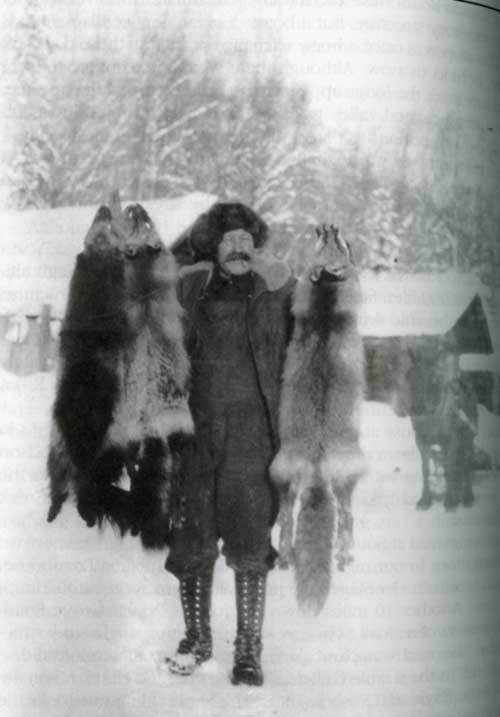 James L Simpson, trapper & horse stable operator, possibly at Tazlina The Copper Center Roadhouse and Trading Post at mile 101 is the former Hotel Holman and Trading Post, also known as Blix’s Roadhouse. It is now operated by Florence Barnes. We passed by a primitive Indian school and a dusty Native settlement north of the lodge. The remains of a government agricultural station and a fox farm just upriver from the lodge were among the growing number of deserted buildings. On the south end of Copper Center, the Klutina River crossing consisted of two bridges with an island in the middle of the river. |
Subscribe to:
Comments (Atom)

